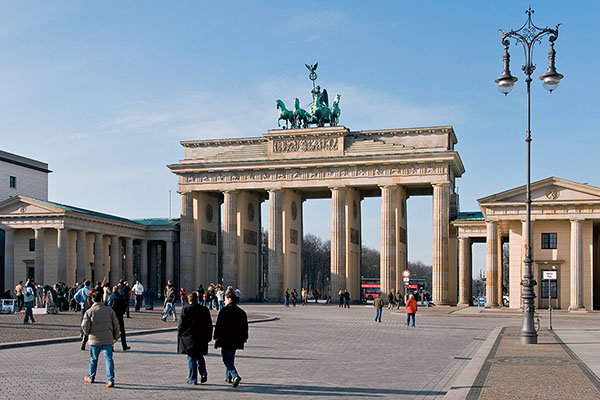
The Brandenburg Gate and Pariser Platz
 |
The Brandenburg Gate and Pariser Platz |
Click on any image to see a larger version!
This page was originally published in March of 2008 and completely redone in February of 2025. All photos were reprocessed from the original raw files, the thumbnail size was increased from 210x140 to 840x560 (displayed as 420x280), and the size of the large images was changed from 900x600 to 2400x1600. A few photos were added to even out the number of images per row. The text has remained essentially the same.
The German capital is a fascinating place, and visiting the city, one has a very strong sense of history. Contrary to what one might experience in a place like Rome, Berlin exudes recent history and reminds us of events that influenced our lives directly. The fall of the wall in 1989 not only ushered in the German reunification; it also signaled the end of the Cold War, a period that marked a large portion of our lives, and of which Berlin is clearly the most famous symbol. Since then, enormous investments have been made in Berlin. On April 19, 1999 the Bundestag (the German parliament) assembled in the Reichstag in Berlin for the first time since the Reichstag fire of February, 1933!
We arrived at Berlin Schönefeld airport in the evening of February 8, 2008, and even though it was dark already, we took an after-dinner walk from our hotel to the center of town. Among other places, we visited the Sony Center [1] at Potsdamer Platz. Around 1 AM, we took the subway back to our hotel from the "Unter den Linden" subway station [2]. To anyone visiting Berlin for more than a couple of days, we recommend the 7 day "Umwelt Karte": for a little more than 30 euros, it entitles the bearer to circulate freely on all public transportation systems in and around Berlin.
The next morning, we took the subway to Nollendorfplatz and walked northwards towards the "Siegessäule" (Victory column). On the way, we crossed the Landwehrkanal [3].
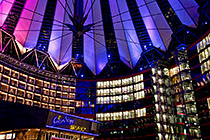
|
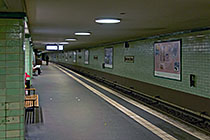
|
Sony Center at Potsdamer Platz |
Unter den Linden subway station, 1:07 a.m. |
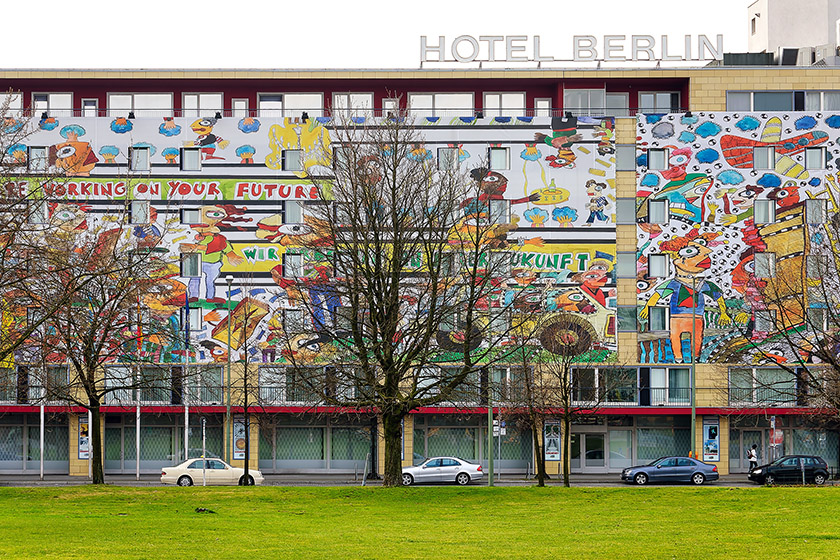
|
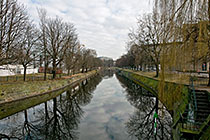
|
The colorful Berlin Hotel |
Landwehrkanal |
The only structure between the Victory Column and the Brandenburg Gate is the Soviet War Memorial [9]. This imposing structure was built by the Soviet Union to honor the 20,000 soldiers of the Soviet Armed Forces who were killed during the Battle of Berlin in April and May of 1945. After the German reunification, the memorial was handed over to the German government that now pays for its upkeep. This is a rather peculiar state of affairs when one stops to think about it.
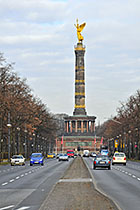
|
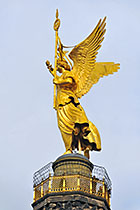
|
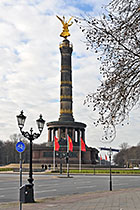
|
Victory Column |
35 ton 'Chick on a Stick' |
The column seen from the East |
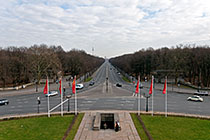
|

|
"Straße des 17. Juni": Street of June 17 |
Strolling through the Tiergarten |
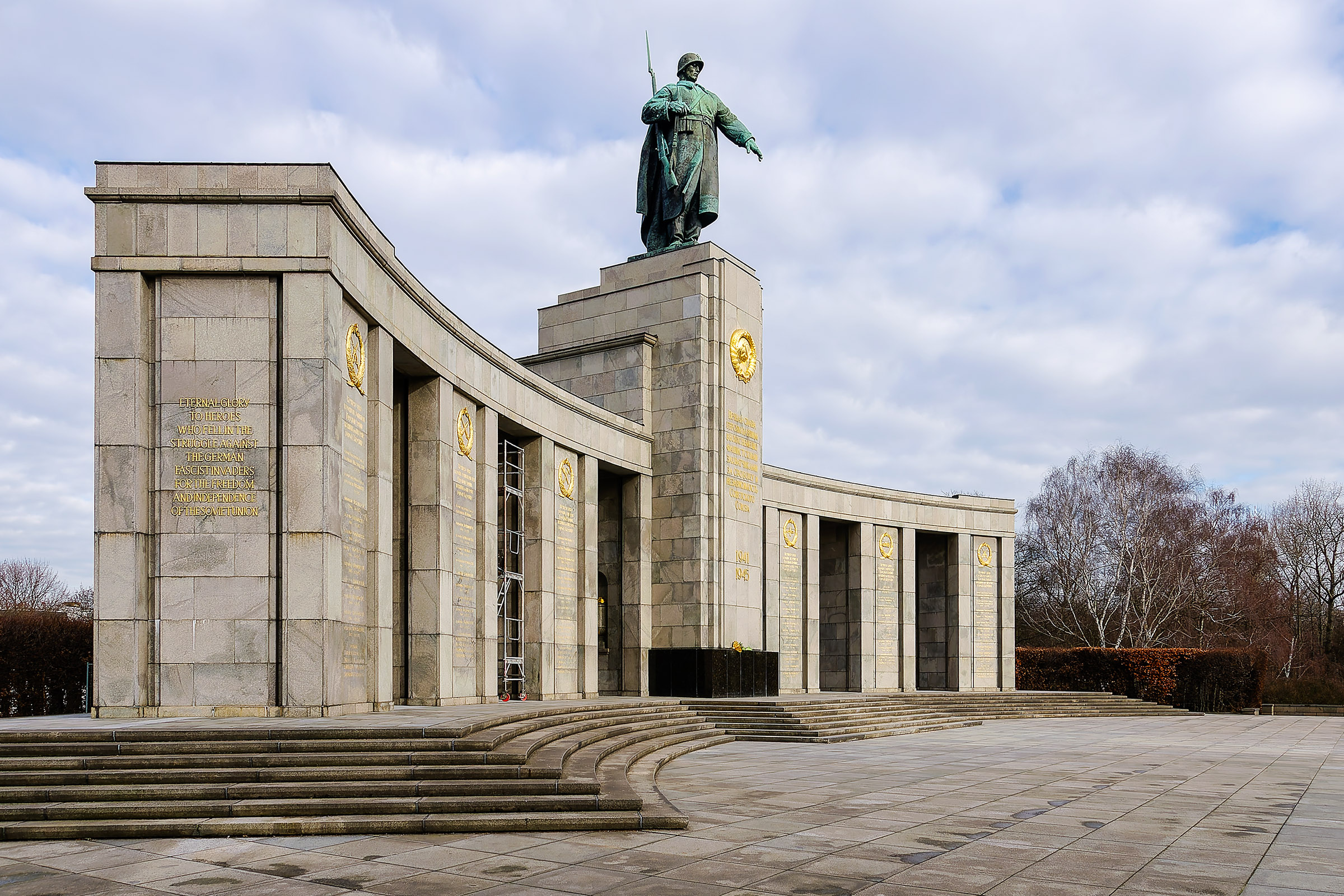
|

|
The Soviet War Memorial |
The Soviet War Memorial |
We then headed north to the Reichstag, the seat of the German parliament [10]. The inscription "Dem Deutschen Volke" (To the German People) [11] was added in 1916, much to the displeasure of Kaiser Wilhelm II who, after all, was not keen on promoting democracy. The story of the Reichstag is really fascinating, and you can read up on it here. Since there was a long line of people waiting to go up to the dome, we decided to return on a different day and walked over to the main train station [12] from where we boarded a train to Friedrichstraße after a brief wait [13]. We then walked to the Gendarmenmarkt, one of the most beautiful squares in Berlin. It features the Concert Hall [14], the German Cathedral [15], the French Cathedral [16], and a statue of German poet Friedrich Schiller [17]. In the distance, one can see the 368 meter (1,207 feet) tall "Fernsehturm" (Television Tower) [18].
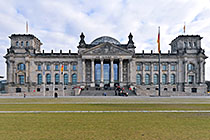
|

|
The Reichstag |
"Dem Deutschen Volke": To the German People |

|
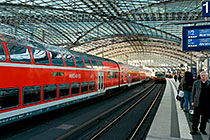
|
Hauptbahnhof: The Main Train Station |
Waiting for our S-Bahn |
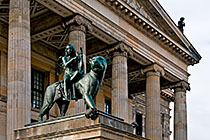
|

|
Gendarmenmarkt Concert Hall... |
...German Cathedral... |
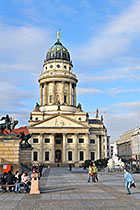
|

|
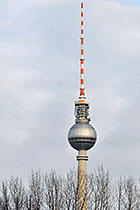
|
...French Cathedral... |
...and Schiller statue. |
Berlin's television tower |
We continued our walk by strolling back to "Unter den Linden" where we passed the Museum of German History [19] and the "Berliner Dom", the Berlin Cathedral [20] on our way to Alexanderplatz. Among other things, the square features the "Rotes Rathaus" (Red Town Hall) [21] and a statue of Marx and Engels [22]. From Alexanderplatz we headed back to our hotel.
The next morning, we finally saw the Brandenburg Gate [23] with its famous Quadriga [24] in daylight!
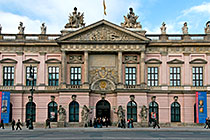
|

|
Museum of German History |
The Berlin Cathedral |
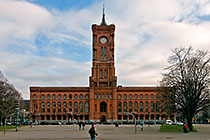
|

|
The Red Town Hall |
Alexanderplatz: Marx and Engels |
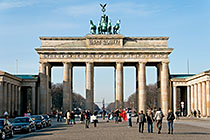
|
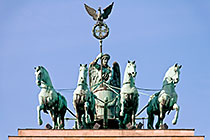
|
The Brandenburg Gate |
Victory driving the Quadriga |
Visiting the Memorial to the Murdered Jews of Europe [25] is, to say the least, a disturbing experience, as we found out next. The memorial takes up an entire city block and consists of 2,711 concrete slabs of various heights arranged in a grid-like pattern. Entering the narrow pathways between the slabs feels perfectly normal at first as they are fairly low [26], but gradually the unevenness of the ground and the growing size of the blocks creates a sense of unease that is hard to explain [27]. Close to the center, the ever-growing blocks take up more and more light and visibility [28] until one gets the feeling of being completely trapped [30]. We could not wait to get out to the edges of the memorial again; from there, things look absolutely normal [30]. The memorial is a perfect metaphor for how an entire segment of the population was sucked into something that initially looked harmless enough, but from which there was ultimately no escape.
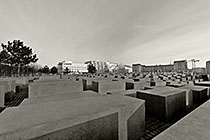
|

|
The impressive Memorial to... |
...the Murdered Jews of Europe... |
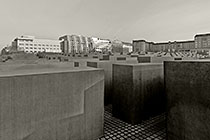
|

|
...consists of 2,711 concrete slabs arranged in a grid pattern. |
It looks harmless enough from the outside... |

|
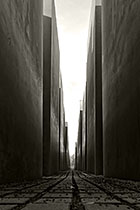
|

|
...but as one moves towards the center... |
...the blocks become larger... |
...until one feels trapped. |
After our visit of the memorial, we walked along the Spree [31] on our way to Friedrichstraße where we boarded a train to the Ostbahnhof, or Eastern Train Station. We wanted to walk along the East Side Gallery, a stretch of the Berlin Wall almost a mile long [32] and covered with the works of many different artists [33]. There are very few openings in the wall, but we did spot this door [34] as well as a crack through which one could see what used to be part of West Berlin [35]. Though the crack is probably recent, it's interesting to speculate what the sight it provides may have meant to a person of East Berlin before the wall came down. The Eastside Gallery ends at the beautiful Oberbaumbrücke [36].
Later that day, we saw the futuristic looking Tempodrom conference and concert center [37] on our way to Checkpoint Charlie a couple of blocks away [38]. One cannot help feel disappointment at the cheap way the site, which was made famous by countless cold war novels and movies, has been commercialized. Nothing is authentic, and posing with fake American or British checkpoint personnel costs one euro [39]. Needless to say, we passed.
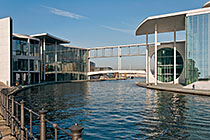
|
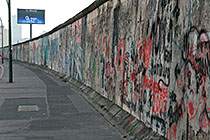
|
Government buildings by the Spree |
Eastside Gallery: The Wall |
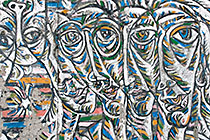
|

|
Wall art |
More wall art |

|
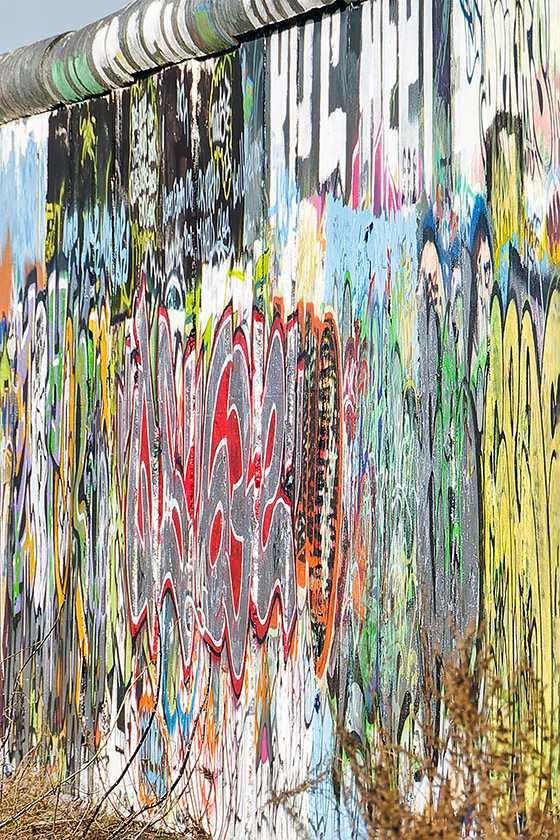
|
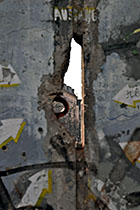
|
A rare door in the wall |
On the other side: far more accessible now... |
...than when it had to be viewed like this. |

|
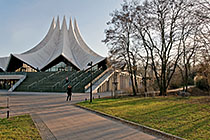
|
The Oberbaum Bridge |
The Tempodrom Convention Center |
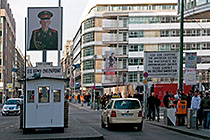
|
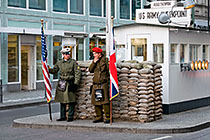
|
Checkpoint Charlie... |
...turned tourist trap! |
Monday, February 11, was our third full day in Berlin, and we decided it was about time we made it up to the Reichstag dome; early in the morning on a weekday, we figured, there would not be too many people. At 8 AM, we emerged from the now familiar "Unter den Linden" subway station, just in time to catch a glimpse of the early morning sun brightening the top of the Brandenburg Gate [40] on our way to the Reichstag. We turned out to be right: there was no line whatsoever, and minutes later we were standing on the roof in front of the dome [41]. The inside of the structure is amazing, especially in the morning light [42]. We slowly made our way up the spiral walkway [43] until we reached the very top of the dome [44]. Fortunately, the weather was cooperating beautifully. As more and more people arrived on the terrace, we made our way down and walked to the main train station. On the way, we crossed the Spree and had a lovely view of the Chancellery [45]. At the station, we boarded a train to Potsdam. Our public transportation pass sure came in handy!
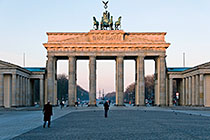
|
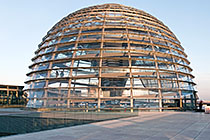
|
Early sun on the Brandenburg Gate |
The Reichstag dome |

|
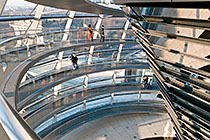
|
Inside the Reichstag Dome |
Walkways spiral up and down |
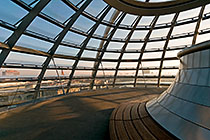
|
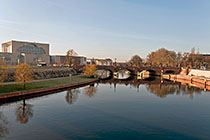
|
At the top of the dome |
The Chancellery by the Spree |
The train ride to Potsdam took approximately an hour, and we arrived at around 10:30 AM. From the main station, we crossed the Havel [46] on our way into town. We followed "Yorkstraße" (York Street) and a portion of the city canal that has recently been reconstructed [47]. Originally, this canal was built for drainage purposes, but it was filled in during the early sixties while Potsdam was part of East Germany. The heart of Potsdam is the somewhat touristy Brandenburger Street that runs from St. Peter and Paul Church in the east [48] to Potsdam's Brandenburg Gate in the west [49]. This is a smaller version of its far more famous counterpart in Berlin; it stands on on "Luisenplatz", a fairly large square [50]. In the same place, we also spotted The hanging Rhino of Potsdam (don't ask!) and a very well preserved "Trabi", a "fancy" 601S model to boot! [51]. This was the pride of East Germany's automobile industry and arguably one of the worst cars ever manufactured. To think people used to have to wait literally years for the privilege of driving one of these things!
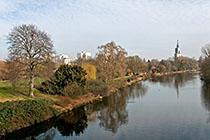
|
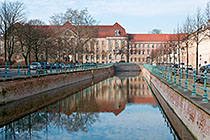
|
Potsdam: the Havel River |
Potsdam City Canal |
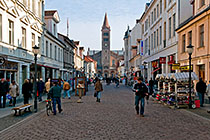
|
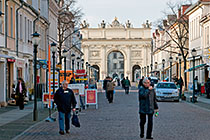
|
Brandenburger Street: looking east |
Brandenburger Street: looking west |
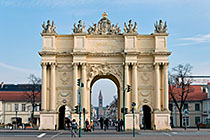
|
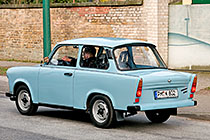
|
Potsdam's Brandenburg Gate |
Trabant 601 S |
We walked the short distance to Sanssouci, the summer palace of Frederick the Great [52]. Obviously, the parks were not at their most impressive in February, but even the building could have done with some work. It would appear that years of neglect have taken their toll, and a great deal of money is now required to restore the palace to its original splendor. Still, the south façade looks lovely [53] and the pergolas are well maintained [54].
After walking back into town, we got on a bus that took us to Cecilienhof in the northeastern part of Potsdam [55]. This magnificent property [56] was the site of the 1945 Potsdam Conference during which the post-war fate of Germany was decided by the allies. The residence lies in a huge park overlooking a beautiful lake, the "Jungfernsee" [57]
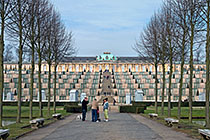
|
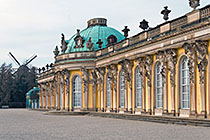
|
Sanssouci Palace |
South façade and the old mill |
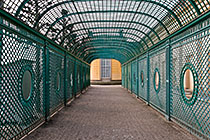
|
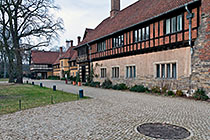
|
Pergola |
The Cecilienhof was the site of... |

|
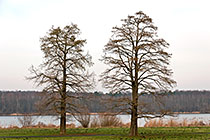
|
...the 1945 Potsdam Conference |
The Jungfernsee |
In the morning of our last full day in Berlin, we took a train to Oranienburg, site of the Sachsenhausen concentration camp. When we got off the train, we found that we had just missed a bus, and since there was only hourly service, we chose to walk. At the visitor center, we rented a couple of audio guides (admission is free of charge) and headed for the main camp entrance with its infamous phrase "Arbeit macht frei" (Work makes [you] free) [58]. Most of what is standing in Sachsenhausen today is reconstructed. To the right of the entrance, there is an area where one can see how difficult it would have been for anyone to escape: a gravel strip, several yards wide, was declared out of bounds, and guards stationed in the watch towers had strict orders to shoot any prisoners found with even a portion of their bodies on the strip. Following the strip were rolls of barbed wire, themselves followed by an electrified fence. Behind that fence was a narrow strip of grass patrolled day and night by guards with attack dogs, and only after that came the actual camp wall [59]. Many prisoners managed to commit suicide by throwing themselves against the electrified fence, or by simply stepping on the gravel strip and waiting for the shot.
One of the few remaining original buildings is the old camp laundry that now houses a museum and movie theater [60], but the largest exhibit area is in the New Museum located by the camp entrance. In particular, it features beautiful stained glass windows [61], [63]. Dominating the entire camp is the Liberation Monument [62]; it was erected in 1961 and is decorated with red triangles because those were the symbols on the camp uniforms of Social Democrats and Communists. It's useful to remember that Sachsenhausen was predominantly a camp for political opponents of the Third Reich and not an extermination camp. The memorial is visible from almost everywhere inside the camp [64]. We briefly visited the reconstructed Jewish barracks 38 and 39 [65] and walked around in silence for a while. Perhaps fittingly, the weather, bright and sunny the previous days, had turned gray for our Sachsenhausen visit. Still, one of the last images I took before leaving, and the one that sticks most in my mind, is this magnificent tree that grows out of a soil fertilized with the ashes of the many thousand people who died here [65].
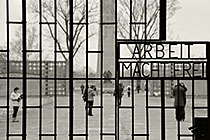
|
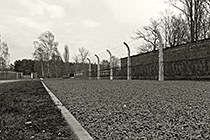
|
Sachsenhausen: "Arbeit macht frei" |
Death strip and fence |
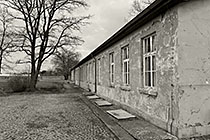
|
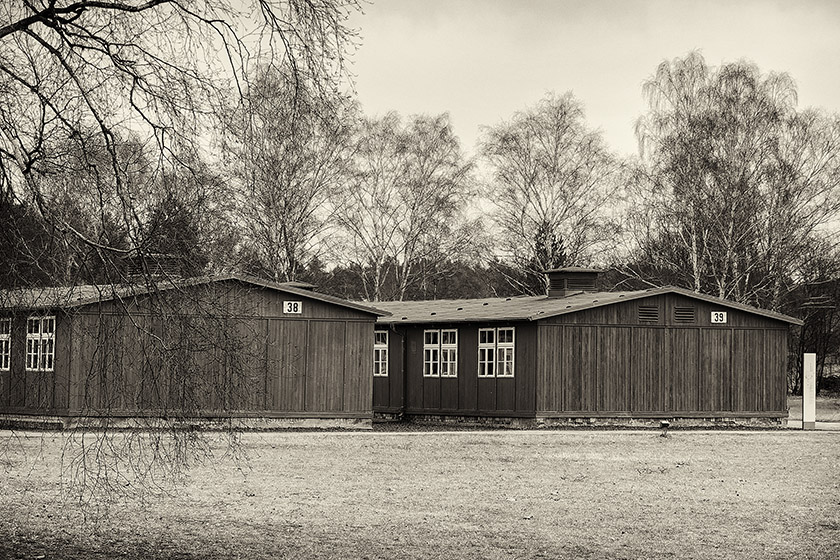
|
The former camp laundry |
Reconstructed Jewish barracks |
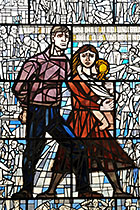
|
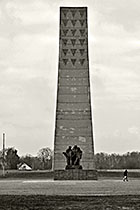
|
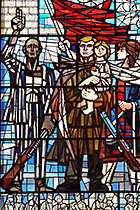
|
Stained glass window in the museum |
The Liberation Monument |
Stained glass window in the museum |
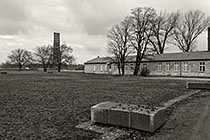
|

|
Sachsenhausen camp view |
Renewal |
We took a train back to Berlin and headed for the shopping district where we had lunch at the Möwenpick at Breitscheidplatz [66]. We also took a look at the Kaiser Wilhelm Memorial Church. This church was destroyed in a bombing raid during the Second World War, and the only thing that remained was a hollow ruin [67], [68]. A new church was built next to the remains which were left standing as a reminder of the horrors of war.
 |
Berlin: Breitscheidplatz |

|
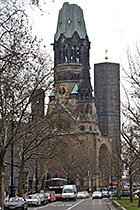
|
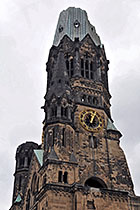
|
The Kaiser Wilhelm Memorial Church |
The unresstored church serves as a warning |
Street Musician |
The next morning, we headed out to Schönefeld airport from where we caught a flight back to Nice. Great trip, fabulous city, fond memories... and two days later, we were in Corsica!
Home | Site Info | Family | The Area | Trips | France | Work | Rants | Photography | Odds & Ends
This page was last modified on March 1, 2025
Send feedback about this page to feedback@kiechle.com
https://www.kiechle.com/trips/berlin/index.htm
(optimized for Retina display)
All contents © 1999-2025 The Kiechles